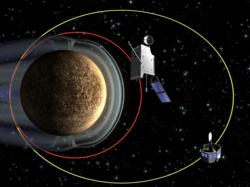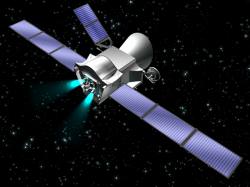British scientists have been given the green light to begin the development of the most advanced ion engines ever to be used in space travel history. Set for launch in 2013, the European/Japanese BepiColombo mission to Mercury will be propelled to the Solar System’s innermost planet by advanced ion engines, with an efficiency equivalent to 17.8 million miles per gallon. This is one very cheap spaceship to fly!
We are currently being dazzled and amazed at the sheer detail of the images being transmitted by NASA’s MESSENGER mission flyby of the tiny planet Mercury. While we watch and wait for MESSENGER to eventually establish an orbit (insertion should occur in the spring of 2011), UK scientists, working with the ESA and Astrium (Europe’s largest space contractor), are hard at work designing the engines for the next big mission to the inner Solar System: BepiColombo. The mission consists of two orbiters: the Mercury Planetary Orbiter (MPO), to carry out mapping tasks over the planet, and the Mercury Magnetospheric Orbiter (MMO), to characterize the planets mysterious magnetosphere. The two craft will travel as one for the 6 year journey to Mercury, but separate at orbital insertion.

Although BepiColombo will use the gravitational pull of the Moon, Earth, Venus and then Mercury to actually get it to its destination, a large amount of energy is required to slow the craft down, countering the Sun’s gravity. Without an engine to thrust against BepiColombo‘s decent into the huge gravitational pull of the Sun, the mission would be doomed to overshoot Mercury and fall to a fiery end. This is where the ion engines come in.
Ion engines have been used in space missions before (such as the SMART-1 mission to the Moon in 2003), but the new generation engines currently undergoing development for the next Mercury mission will be far more efficient while providing sufficient thrust. Better efficiency means less fuel. Less fuel means less mass and volume, saving on launch cost and allowing more room for scientific instrumentation.
Ion engines work by channeling electrically charged particles (ions) through an electric field. Doing this accelerates the ions to high velocities. Each particle has a mass (albeit tiny), so each particle also carries a momentum when fired from the engine. Shoot enough particles out of the engine and you produce a thrust the spacecraft can use to accelerate or (in the case of BepiColombo) slow down. Ion engines do have a drawback. Although they are fuel efficient, the thrust can be small, so missions can take longer to complete; time must be allowed for the long-term thrust to have an effect on the velocity of the spacecraft. However, this shortfall for ion propulsion won’t deter space scientists from using this new technology, as the pros definitely outweigh the cons.
So, we can now look forward to over a decade of exploration of Mercury by MESSENGER and BepiColombo, one of the most uncharted and mysterious planets to orbit the Sun.
Source: Telegraph.co.uk


its good very nice it was interesting
The mission name is “BepiColombo” and not “BepiColumbo”. The mission was named in honor of Giuseppe Colombo, Italian professor of Celestial Mechanics. Thanks to his ideas, Mariner 10 was able to do 3 Mercury flybys on 1974 and 1975, instead of the only one planned.
To Sh^ea dear Planetwatcher….To Sh^ea
To Mario Di, Thanks for the spelling correction, my reference was incorrectly spelt too. All changed now. Cheers! Ian
Why not use solar sails for propulsion to keep from falling into the Sun? since the Sun is the source of solar propulsion.
I’d like to read about how the new Ion engines are more advanced. On what dimension are Ion engines advancing? Thrust? Efficiency? Speed? Fuel? What elements of their design is evolving? The story about “most advanced Ion engins” didn’t address that topic.
I am with Robert O’Neal.
Where’s the beef?
We must have more information!
Ion engines are cool.
The name itself is even cool sounding.
It sounds so super high tech and futurey.
Ok, so give us more, baby!
I’m a bit worried about “efficiency” figures in miles per gallon here on two counts:
I suspect this is for the propellant, whereas the energy for propulsion will come from some form of electrical generator.
And anyway, as a general feature, once the acceleration is over, spacecraft have the potential to carry on indefinitely without further use of fuel – an infinite number of miles per gallon.
Perhaps I should give them the benefit of the doubt and guess it was calculated for this specific mission.
i would guess the specific impulse of the ion engines will be 10,000- 15,000 seconds
tim
Hi Manuel Herman:
Using the wonders of google conversion, 17.8 million miles per gallon = 7.6 million kilometers per liter – have no clue if that’s a UK gallon or US gallon though 😉
Ian
Hi all! Please Ian, could you write down the equivalence of this measures in International Sistem measures?
Miles / gallon don’t makes many sense to me, and for any non-anglo reader I suposse, what about kilometers / litre?
Thanks!
Thanks Ian, could be a good habit put all measures in I.S. units, or at least in both systems. It´s quite annoying to read an article with the unit conversor in another tab 😉
Great article!
“with an efficiency equivalent to 17.8 million miles per gallon”
Rockets in space dont work that way. Voyager has an infinite MPG rating since it will never stop going (or almost never). Sometimes cool sounding things should not be included in science news because they are wrong.
ISP is the number you want to quote, and then you compare it to the Space Shuttle. That would bring it down to earth and give Johneveryreader a chuckle.